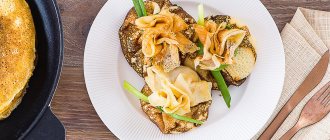Croissants are the most popular baked goods in France.
They are prepared almost everywhere: in pastry shops, cafes, restaurants and at home. Croissants are served with tea, cocoa or coffee.
Puff pastry requires certain knowledge and skills, so not every housewife can prepare it so that it is airy and crispy.
But today you can buy ready-made dough at any store, which greatly simplifies the process of making croissants.
Croissants from ready-made dough - basic principles of preparation
Croissants are made from puff pastry. In this case, both yeast and yeast-free products are used. The filling can be salty or sweet.
Chocolate, berries, jam, fruit, preserves or condensed milk are used as fillings for sweet croissants made from ready-made dough.
For savory croissants, the fillings can be very different. This could be cottage cheese with herbs, ham, cheese, mushrooms or other products.
The finished dough is defrosted, unrolled and placed on a floured table. The leaf is cut into long strips, the width of your palm. Then cut each strip into triangles.
Place the filling on the wide part and wrap the dough into a roll. Place the finished croissants from the prepared dough on a baking sheet lined with parchment. Each is brushed with beaten egg and baked in an oven preheated to 220ºC for a quarter of an hour.
Puff pastry croissants with apricots
See how easy it is to make pies filled with fresh apricots.
Cooking method
Take out the yeast puff pastry, unwrap it and let it warm up and rise in volume.
Using a large knife, first cut the dough into 4 strips, depending on the size of the sheets. And then cut the strips from corner to corner to make triangles.
Place half an apricot over the area of most of the triangle.
Stretch the dough with your fingers to the sides near the filling to create the opportunity to twist half of the fruit with it.
Sprinkle sugar into each apricot half. Without sugar the filling will be sour.
Fold the ends of the puff pastry triangle forward and secure with pressure.
Then twist the dough together with the apricot and again, using your fingers, press along the edges of the filling to secure it with the other part of the triangle. It will turn out like an ordinary dumpling.
Twist the remaining part of the triangle around the dumpling.
On your palm you will get a dough product in the form of a twisted dough with filling.
Place the rolled croissants on a baking sheet lined with baking paper. Brush the top with beaten egg.
Bake for 15 minutes in the oven at 200 degrees C.
Sprinkle the finished croissants with powdered sugar.
Break open the bagel to reveal the filling. In the crack of the bagel, the yellow apricot filling peeks out beautifully.
Recipe 1. Croissants from ready-made dough with condensed milk
Ingredients
half a kilogram of puff pastry;
egg;
butter – 150 g;
150 g boiled condensed milk.
Cooking method
1. Defrost the dough. Sprinkle the table with flour and unfold a sheet of puff pastry on it. Roll it out slightly. Cut the sheet into wide strips. Then we cut each strip into triangles.
2. Melt the butter and mix with boiled condensed milk. Place a teaspoon of boiled condensed milk filling on the wide side of the triangle and roll the dough into a roll.
3. Place the croissants on a deco lined with baking paper. Beat the egg and brush each bagel with it.
4. Preheat the oven to 200 C. Place the deco with croissants in the oven and bake them for half an hour. Place the finished baked goods on a dish and sprinkle with powdered sugar.
Baking croissants
Any professional pastry chef will tell you that making croissants takes skill and experience. Any tourist who has had breakfast in a Parisian bistro will be categorical: the best croissants are born in France. There, by the way, specially trained people are responsible for these baked goods; they only prepare them. So, let's buy very good unsalted butter (at least 82% fat), premium wheat flour, milk with a fat content of at least 3%, dry yeast and sugar. And let's choose a day when we have a lot of free time. So, chop 350 g of cold butter, or better yet, knead it with your hands and mix with 3 tbsp. l. flour. Knead the mixture well until it becomes homogeneous, without any hard lumps of oil. It is desirable that the oil remains cold and does not spread. Place the butter on cling film and shape into a rectangle. Wrap and cool. Whisk 200–250 ml of warm milk, a little more than 2 tsp. dry yeast and 1 tbsp. l. Sahara. Leave for 5–7 minutes. until the yeast is completely dissolved. In a large bowl, mix 25 g of butter, previously chopped into pieces, 400 g of wheat flour and half a teaspoon of salt. Add milk-yeast mixture. Stir and transfer the dough to the table. Knead well. The dough should become smooth and homogeneous. Cool it to 10–20 degrees. Then the butter with which we will sandwich the dough will not melt on it. After the dough has cooled, you need to sprinkle it with flour and roll it into a rectangle 5–8 mm thick. Up to this point, all recipes for making croissants are very similar in technology. Only the volumes and weights of the starting ingredients differ. Then the essence of the process comes down to the fact that butter is placed between the layers of dough and the resulting rectangle is rolled out with a rolling pin to the desired thickness (about 1 cm). This way the butter is practically sealed into the flour mixture. In cookbooks, this process is often called “rolling.” At the same time, you can fold the dough in different ways. The easiest way is to initially divide the dough into three equal parts and “butter” them. You should get a pastry consisting of three layers of dough and two layers of butter. The description of a more complex option simultaneously resembles recommendations for folding origami and instructions for using household appliances. This is probably the very difficulty that professional chefs warn us about. Let's try to figure it out:
“Fold the ungreased surface over half of the greased surface and cover with the remaining greased surface. You will get a three-layer rectangle measuring approximately 17 x 20 cm. Seal the edges of the dough well with your hands so that the butter does not squeeze out when further rolling out the dough. Turn the dough 90 degrees to the right and roll out again into a rectangle measuring 50 x 20 cm.” The more rolls you make, the better. Ideally, you should end up with a layer of dough with 16, 24 or even 32 layers of butter. Such a large number of folds prevents oil from leaking out during baking. For better layering of the product, you can sprinkle the butter a little with sugar. It is recommended to layer the dough at a temperature no higher than 18–20 °C, so baking croissants is clearly not for stuffy summer evenings. After completing this difficult procedure, the dough is either immediately refrigerated, or the croissants are first formed and sent to the refrigerator. In smart books they write that the dough should be left for 1 to 24 hours. Leave the dough in the refrigerator overnight - you can't go wrong. Preheat the oven to 240 °C and for 10–15 minutes. we put “crescents” in it. A minute or two before the end of baking, we recommend reducing the temperature by 20 °C. All that remains is to get the fluffy, golden, crispy croissants and make coffee.
Recipe 4. Croissants from ready-made dough with ham and cream cheese
Ingredients
yeast-free puff pastry – 500 g;
curd cheese – 100 g;
200 g ham;
egg.
Cooking method
1. Completely defrost the finished puff pastry and divide it in half.
2. Roll out one part into a thin circle and cut it into triangular segments.
3. Grate the ham on a coarse grater. Place the cottage cheese in a plate with high sides and mash it with a fork. Add ham to it and stir.
4. Place some cheese and ham filling on the wide part of the triangle. We wrap the dough with the filling into a roll and place it on a baking sheet covered with parchment.
5. Place the baking sheet with croissants in the oven and bake at 180 C for half an hour. Serve the baked goods with broth or soup.
Step-by-step preparation
- Let's start by preparing yeast-free puff pastry. If you already have ready-made dough, then go straight to step 11. Sift 650 grams of first-grade flour into a deep bowl.
- Next, take 360 grams of chilled butter, coat it in flour and grate it on a coarse grater. Mix everything thoroughly.
- Take 220 milliliters of chilled water, add 1 teaspoon of salt to it and stir until completely dissolved.
- Add 1 teaspoon of 9% lemon juice or lemon juice to water with salt. Also mix.
- Gradually add water to the butter and flour mixture, stirring with a spoon.
- We collect the dough into one lump as quickly as possible; there is no need to knead it. The dough should stick to your hands a little.
- We form a brick from the dough, wrap it in a bag and put it in the refrigerator to cool for 1 hour.
- Using a kitchen rolling pin, roll out the dough into a rectangle, lightly sprinkle with flour and fold the dough into 3 layers.
- Place the dough on a board, cover the top with a bag and place in the refrigerator for another 30 minutes.
- Cut the dough into 2 parts, each weighing 600 grams. The dough is ready to use.
- Sprinkle the board for rolling out the dough with first grade wheat flour and unroll a layer of puff pastry weighing 500-600 grams. Cut the dough into 2 parts, this will make it easier to roll out.
- Roll out the dough with a kitchen rolling pin so that its thickness is 2-3 millimeters. We form a rectangle from the resulting dough, cutting off the excess dough with a knife.
- We divide the resulting rectangle into smaller rectangles, and then cut the small rectangles in half, getting triangles.
- Place 1 teaspoon of strawberry jam on the wide part of the triangle and roll it into a croissant. There is no need to spread the jam. Line a baking sheet with parchment paper and place the croissants on it.
- Break 1 chicken egg into a cup, mix it a little and brush all the croissants on top.
- Turn on the oven, preheat it to 190 degrees and bake the croissants for 25 minutes. Bon appetit!
About urban and rural bread in the history of France
From the very moment of its appearance, baguette was considered a “city bun”, as opposed to rural bakery products. Country French bread was traditionally round in shape. Village bread was made from different types of flour, often with bran and other ingredients added to it. It is not difficult to understand that this was not done out of a beautiful life - they added what was available. Baguette became bread, which had its own clear recipe and was therefore more associated with prosperity and a happy city life. Today, even the poorest Frenchman can afford to buy a baguette and crunch on its delicious crust. Finding joy in the little things in life is something that those who come to live in France should learn from the French.
But despite the uniform recipe, baguette in France still has several varieties.
1) Classic baguette. You can easily recognize it by its brown-golden crust. These baguettes are baked by private bakeries. Many bakeries in France bake so many baguettes that they are immediately sold out, fresh and still hot.
2) Industrial baguette. It is baked in large batches in industrial ovens. Usually on the back of such a baguette there is a small pattern of many small circles, and this will convince you that this is exactly the variety you are looking at.
3) Farine - the same baguette, but sprinkled with white flour. There is also a sweet variety of this product, which is no longer considered a baguette in the traditional sense, but is also very tasty in its own way.
What does it take to make a good croissant?
This requires a lot. Those who came to live in France
and even more so, the French themselves are well versed in this. For example, strictly follow the technology. The problem is that each croissant specialist has his own technology, and you shouldn’t think that he will immediately share it - it’s a secret, and often a family secret.
In addition, it is important to take care of the quality of the products. Butter, flour and all other components - the high quality of each of these products can have a decisive influence on whether the croissant turns out tasty or not.
The third is the baking method, that is, the equipment. There are two options - either a regular oven, in which most baked goods are baked, or a combi oven. If a croissant is baked in a conventional oven, then it is more elastic, and if in a combi oven, then it is more crumbly. By all rules, a good croissant should tend to be crumbly, although, of course, it has no right to fall apart. Croissants baked using the second method are considered more promising and are in greatest demand.
According to French tradition, true croissants are those that do not contain filling. However, today you can try products that violate this rule, but this does not make them less tasty.
Butter symbol of France
Puff pastry croissants were born in the depths of European bakeries in the early 1920s. There is still a debate about which city is their homeland: Vienna or Paris. In any case, the French croissant became the progenitor of a whole family of yeast breads.
A beautiful legend about the origin is associated with military actions, when at the end of the 17th century the Ottoman army besieged the capital of Austria. The bakers working that night learned that an undermining was being prepared under the walls of Vienna, and warned the defenders of the city. As a result, the plan failed, and the enemies went home.
As a sign of victory over the great army of the Ottoman Empire, confectioners baked buns in the shape of a crescent, which was depicted on the enemy’s flag.










